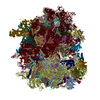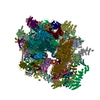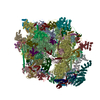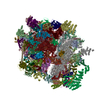[English] 日本語
 Yorodumi
Yorodumi- EMDB-2511: Cryo-EM of the Sec61-complex bound to an 80S-RNC engaged with a t... -
+ Open data
Open data
- Basic information
Basic information
| Entry | Database: EMDB / ID: EMD-2511 | |||||||||
|---|---|---|---|---|---|---|---|---|---|---|
| Title | Cryo-EM of the Sec61-complex bound to an 80S-RNC engaged with a translocating LepT chain | |||||||||
 Map data Map data | Reconstruction of 80S-RNC-Sec61 complex engaged with translocating nascent chain (LepT) | |||||||||
 Sample Sample |
| |||||||||
 Keywords Keywords | Co-translational protein translocation | |||||||||
| Function / homology |  Function and homology information Function and homology informationInsertion of tail-anchored proteins into the endoplasmic reticulum membrane / membrane docking / endoplasmic reticulum Sec complex / pronephric nephron development / cotranslational protein targeting to membrane / Ssh1 translocon complex / Sec61 translocon complex / protein targeting to ER / protein insertion into ER membrane / protein-transporting ATPase activity ...Insertion of tail-anchored proteins into the endoplasmic reticulum membrane / membrane docking / endoplasmic reticulum Sec complex / pronephric nephron development / cotranslational protein targeting to membrane / Ssh1 translocon complex / Sec61 translocon complex / protein targeting to ER / protein insertion into ER membrane / protein-transporting ATPase activity / SRP-dependent cotranslational protein targeting to membrane, translocation / signal sequence binding / post-translational protein targeting to membrane, translocation / protein transmembrane transporter activity / guanyl-nucleotide exchange factor activity / phospholipid binding / ribosome binding / endoplasmic reticulum membrane / endoplasmic reticulum / membrane Similarity search - Function | |||||||||
| Biological species |   | |||||||||
| Method | single particle reconstruction / cryo EM / Resolution: 7.4 Å | |||||||||
 Authors Authors | Gogala M / Becker T / Beatrix B / Barrio-Garcia C / Berninghausen O / Beckmann R | |||||||||
 Citation Citation |  Journal: Nature / Year: 2014 Journal: Nature / Year: 2014Title: Structures of the Sec61 complex engaged in nascent peptide translocation or membrane insertion. Authors: Marko Gogala / Thomas Becker / Birgitta Beatrix / Jean-Paul Armache / Clara Barrio-Garcia / Otto Berninghausen / Roland Beckmann /  Abstract: The biogenesis of secretory as well as transmembrane proteins requires the activity of the universally conserved protein-conducting channel (PCC), the Sec61 complex (SecY complex in bacteria). In ...The biogenesis of secretory as well as transmembrane proteins requires the activity of the universally conserved protein-conducting channel (PCC), the Sec61 complex (SecY complex in bacteria). In eukaryotic cells the PCC is located in the membrane of the endoplasmic reticulum where it can bind to translating ribosomes for co-translational protein transport. The Sec complex consists of three subunits (Sec61α, β and γ) and provides an aqueous environment for the translocation of hydrophilic peptides as well as a lateral opening in the Sec61α subunit that has been proposed to act as a gate for the membrane partitioning of hydrophobic domains. A plug helix and a so-called pore ring are believed to seal the PCC against ion flow and are proposed to rearrange for accommodation of translocating peptides. Several crystal and cryo-electron microscopy structures revealed different conformations of closed and partially open Sec61 and SecY complexes. However, in none of these samples has the translocation state been unambiguously defined biochemically. Here we present cryo-electron microscopy structures of ribosome-bound Sec61 complexes engaged in translocation or membrane insertion of nascent peptides. Our data show that a hydrophilic peptide can translocate through the Sec complex with an essentially closed lateral gate and an only slightly rearranged central channel. Membrane insertion of a hydrophobic domain seems to occur with the Sec complex opening the proposed lateral gate while rearranging the plug to maintain an ion permeability barrier. Taken together, we provide a structural model for the basic activities of the Sec61 complex as a protein-conducting channel. | |||||||||
| History |
|
- Structure visualization
Structure visualization
| Movie |
 Movie viewer Movie viewer |
|---|---|
| Structure viewer | EM map:  SurfView SurfView Molmil Molmil Jmol/JSmol Jmol/JSmol |
| Supplemental images |
- Downloads & links
Downloads & links
-EMDB archive
| Map data |  emd_2511.map.gz emd_2511.map.gz | 5.6 MB |  EMDB map data format EMDB map data format | |
|---|---|---|---|---|
| Header (meta data) |  emd-2511-v30.xml emd-2511-v30.xml emd-2511.xml emd-2511.xml | 10 KB 10 KB | Display Display |  EMDB header EMDB header |
| Images |  EMD-2511-LepT_for_EMDB.jpg EMD-2511-LepT_for_EMDB.jpg | 678.1 KB | ||
| Archive directory |  http://ftp.pdbj.org/pub/emdb/structures/EMD-2511 http://ftp.pdbj.org/pub/emdb/structures/EMD-2511 ftp://ftp.pdbj.org/pub/emdb/structures/EMD-2511 ftp://ftp.pdbj.org/pub/emdb/structures/EMD-2511 | HTTPS FTP |
-Validation report
| Summary document |  emd_2511_validation.pdf.gz emd_2511_validation.pdf.gz | 242.7 KB | Display |  EMDB validaton report EMDB validaton report |
|---|---|---|---|---|
| Full document |  emd_2511_full_validation.pdf.gz emd_2511_full_validation.pdf.gz | 241.8 KB | Display | |
| Data in XML |  emd_2511_validation.xml.gz emd_2511_validation.xml.gz | 7 KB | Display | |
| Arichive directory |  https://ftp.pdbj.org/pub/emdb/validation_reports/EMD-2511 https://ftp.pdbj.org/pub/emdb/validation_reports/EMD-2511 ftp://ftp.pdbj.org/pub/emdb/validation_reports/EMD-2511 ftp://ftp.pdbj.org/pub/emdb/validation_reports/EMD-2511 | HTTPS FTP |
-Related structure data
| Related structure data |  4cg5MC  2510C  2512C  4cg6C  4cg7C  4v7eC M: atomic model generated by this map C: citing same article ( |
|---|---|
| Similar structure data |
- Links
Links
| EMDB pages |  EMDB (EBI/PDBe) / EMDB (EBI/PDBe) /  EMDataResource EMDataResource |
|---|---|
| Related items in Molecule of the Month |
- Map
Map
| File |  Download / File: emd_2511.map.gz / Format: CCP4 / Size: 185.7 MB / Type: IMAGE STORED AS FLOATING POINT NUMBER (4 BYTES) Download / File: emd_2511.map.gz / Format: CCP4 / Size: 185.7 MB / Type: IMAGE STORED AS FLOATING POINT NUMBER (4 BYTES) | ||||||||||||||||||||||||||||||||||||||||||||||||||||||||||||||||||||
|---|---|---|---|---|---|---|---|---|---|---|---|---|---|---|---|---|---|---|---|---|---|---|---|---|---|---|---|---|---|---|---|---|---|---|---|---|---|---|---|---|---|---|---|---|---|---|---|---|---|---|---|---|---|---|---|---|---|---|---|---|---|---|---|---|---|---|---|---|---|
| Annotation | Reconstruction of 80S-RNC-Sec61 complex engaged with translocating nascent chain (LepT) | ||||||||||||||||||||||||||||||||||||||||||||||||||||||||||||||||||||
| Projections & slices | Image control
Images are generated by Spider. | ||||||||||||||||||||||||||||||||||||||||||||||||||||||||||||||||||||
| Voxel size | X=Y=Z: 1.2374 Å | ||||||||||||||||||||||||||||||||||||||||||||||||||||||||||||||||||||
| Density |
| ||||||||||||||||||||||||||||||||||||||||||||||||||||||||||||||||||||
| Symmetry | Space group: 1 | ||||||||||||||||||||||||||||||||||||||||||||||||||||||||||||||||||||
| Details | EMDB XML:
CCP4 map header:
| ||||||||||||||||||||||||||||||||||||||||||||||||||||||||||||||||||||
-Supplemental data
- Sample components
Sample components
-Entire : Canis familiaris Sec61 bound to a wheat germ 80S-RNC translating ...
| Entire | Name: Canis familiaris Sec61 bound to a wheat germ 80S-RNC translating the translocating LepT-polypeptide |
|---|---|
| Components |
|
-Supramolecule #1000: Canis familiaris Sec61 bound to a wheat germ 80S-RNC translating ...
| Supramolecule | Name: Canis familiaris Sec61 bound to a wheat germ 80S-RNC translating the translocating LepT-polypeptide type: sample / ID: 1000 / Oligomeric state: One Sec61 binds to one 80S ribosome / Number unique components: 2 |
|---|
-Supramolecule #1: 80S Ribosome
| Supramolecule | Name: 80S Ribosome / type: complex / ID: 1 / Recombinant expression: No / Ribosome-details: ribosome-eukaryote: ALL |
|---|---|
| Source (natural) | Organism:  |
-Macromolecule #1: Sec61-complex
| Macromolecule | Name: Sec61-complex / type: protein_or_peptide / ID: 1 / Name.synonym: Dog pancreas Sec61-complex / Details: Data-subset resulted from computational sorting / Number of copies: 1 / Oligomeric state: Monomer / Recombinant expression: No |
|---|---|
| Source (natural) | Organism:  |
| Molecular weight | Theoretical: 69.9 KDa |
-Experimental details
-Structure determination
| Method | cryo EM |
|---|---|
 Processing Processing | single particle reconstruction |
| Aggregation state | particle |
- Sample preparation
Sample preparation
| Buffer | pH: 7.6 Details: 30 mM Hepes/KOH 7.6, 10 mM Mg(OAc)2, 180 mM KOAC/HAc pH 7.6, 0.3 % Digitonin, 1 mM DTT |
|---|---|
| Grid | Details: Quantifoil grids pre-coated with 2 nm carbon on top |
| Vitrification | Cryogen name: ETHANE / Chamber humidity: 95 % / Instrument: FEI VITROBOT MARK IV / Method: Blot for 3 seconds before plunging |
- Electron microscopy
Electron microscopy
| Microscope | FEI TITAN KRIOS |
|---|---|
| Date | Jul 17, 2011 |
| Image recording | Category: CCD / Film or detector model: TVIPS TEMCAM-F416 (4k x 4k) / Number real images: 9805 / Average electron dose: 25 e/Å2 / Bits/pixel: 16 |
| Electron beam | Acceleration voltage: 200 kV / Electron source:  FIELD EMISSION GUN FIELD EMISSION GUN |
| Electron optics | Calibrated magnification: 148721 / Illumination mode: FLOOD BEAM / Imaging mode: BRIGHT FIELD / Cs: 2.7 mm / Nominal defocus max: 4.0 µm / Nominal defocus min: 1.3 µm |
| Sample stage | Specimen holder model: FEI TITAN KRIOS AUTOGRID HOLDER |
| Experimental equipment |  Model: Titan Krios / Image courtesy: FEI Company |
- Image processing
Image processing
| Details | The particles were selected using SIGNATURE, classified using MAPPOS and processed with SPIDER |
|---|---|
| CTF correction | Details: On 3D-volume (SPIDER) |
| Final reconstruction | Applied symmetry - Point group: C1 (asymmetric) / Resolution.type: BY AUTHOR / Resolution: 7.4 Å / Resolution method: OTHER / Software - Name: SPIDER, Signature, MAPPOS / Number images used: 53248 |
 Movie
Movie Controller
Controller















 Z (Sec.)
Z (Sec.) X (Row.)
X (Row.) Y (Col.)
Y (Col.)






















